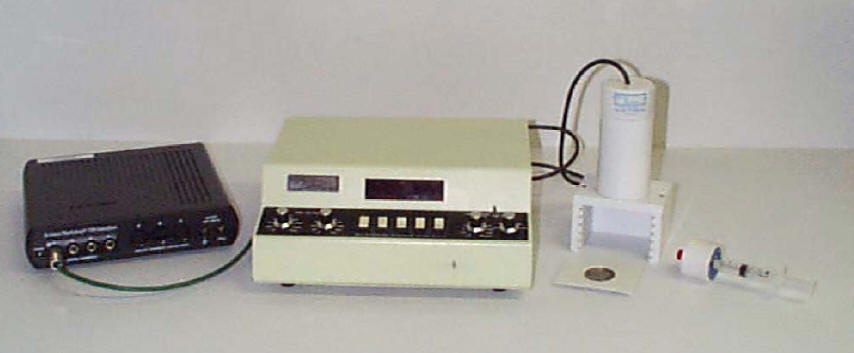

In this laboratory you will determine radioactive the half-life of Barium-137m, a metastable state of Barium. You will measure the activity of the Ba-137m as a function of time by detecting the gamma rays with a Geiger-Mueller (GM) tube. From the data you will determine the decay constant and the half-life of the sample.
Background information:
The decay constant of a radioactive sample cannot be measured instantaneously. The number of radioactive decays must be measured over a series of short time intervals. The decay rate R = R0 exp(-λt) of the sample decreases exponentially with time. The number of particles detected with a GM tube is a fraction of the total number of decays since the radiation is emitted from the source in all directions and the detector only intercepts a small portion of these directions. The detector also has less than 100% efficiency for counting particles that enter it. Detectors cannot accurately count particles that enter nearly simultaneously. This dead-time problem can be avoided by keeping the count rates low enough, so that chance of two particles entering within a time interval smaller than the time resolution of the detector/counter system is negligible. The detected number of particles per unit time interval is then proportional to the activity of the sample and has the same decay constant.
Background radiation is a common source of error when measuring radioactive decay. This error can lead to inaccuracies in the determination of the half-life. The background radiation comes from many naturally occurring sources and from cosmic rays entering our upper atmosphere from space. Background radiation is a constant addition to the activity from the sample. It does not exponentially decay and cannot be fitted with an exponential function. To account for the background we must fit our results with an exponential function plus a constant offset.
The source of the Ba-137m is an isotope generator consisting of an exempt quantity of Cs-137. An exempt quantity is a quantity small enough so that no license is required to purchase the material. It is deemed to be a minimal health hazard. The Cesium atoms are in molecules of a Cesium salt, CsCl, that have been adsorbed by small beads of a resin material. The Ba-137m nuclei are a daughter product that results from the λ-decay of Cs-137.
13755Cs --> 137m56Ba + e- + νe.
As the Cs-137 nuclei decay to the Ba-137m nuclei, the Ba-137m atoms remain adsorbed on the surface of the resin. But because Barium has a different chemistry than Cesium, it is more loosely bound to the resin and can be de-adsorbed with a weakly acidic salt solution containing HCI and NaCI. Small amounts of the short lived Ba-137m isotope can be extracted from the resin by this eluting solution. The Cesium nuclei have a half-life of 30 years and Cesium is always decaying, building up an equilibrium amount of Ba-137m. Ba-137m has a short half-life and quickly decays down to its stable ground state by the emission of a 0.662 MeV gamma ray.
The Ba-137m is said to be selectively "milked" from the generator that is sometimes called a "cow." The Ba-137m daughter product is washed out of the generator, and the Cesium parent product is left behind to regenerate additional Ba-137m atoms. Equilibrium is again reached in less than an hour. Since Ba-137m has a short half-life, it only takes 30 minutes after a sample is acquired for the residual activity in the solution to essentially disappear.
However, should a spill occur, wipe up any liquid
and wash any exposed skin thoroughly with soap and water.
Equipment needed:

Procedure:
Data Analysis: